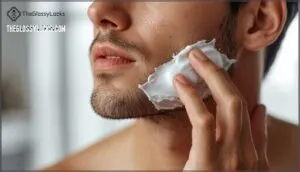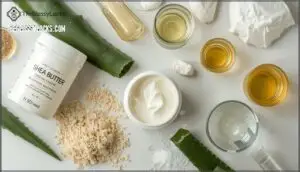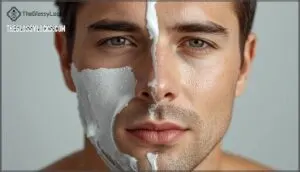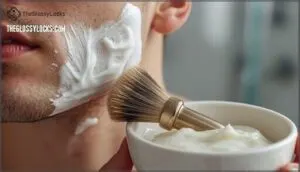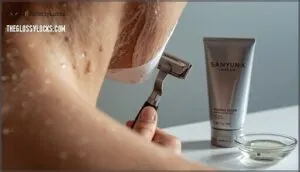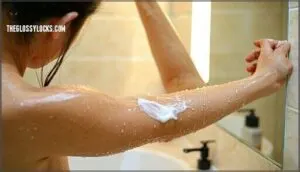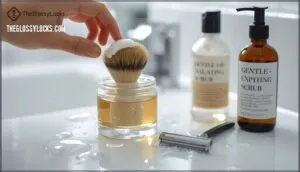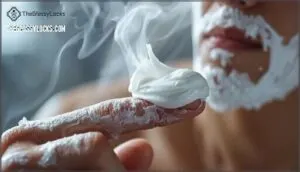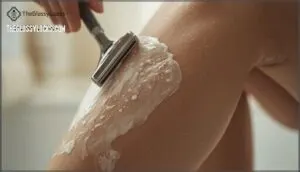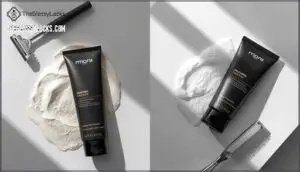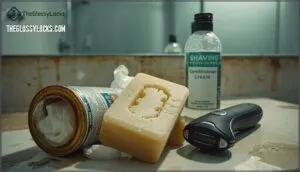This site is supported by our readers. We may earn a commission, at no cost to you, if you purchase through links.
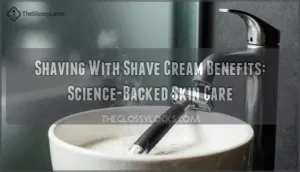 Your razor might be sharp, but without proper preparation, you’re asking your skin to endure a lot. Studies show that shaving with shave cream benefits your skin by reducing friction between blade and face by up to 60%, turning what could be an aggressive daily ritual into something your skin can actually tolerate.
Your razor might be sharp, but without proper preparation, you’re asking your skin to endure a lot. Studies show that shaving with shave cream benefits your skin by reducing friction between blade and face by up to 60%, turning what could be an aggressive daily ritual into something your skin can actually tolerate.
The difference isn’t just comfort—it’s about preventing the micro-trauma that leads to irritation, ingrown hairs, and that telltale redness you see after a rushed morning shave. Think of shaving cream as your skin’s first line of defense, creating a protective barrier that lets the blade do its job without collateral damage.
The right formulation, applied correctly, transforms shaving from a necessary evil into genuine skin care.
Table Of Contents
- Key Takeaways
- What Does Shaving Cream Do?
- Key Benefits of Using Shave Cream
- Shaving Cream Ingredients That Matter
- How Shave Cream Supports Skin Health
- Preventing Razor Burn and Irritation
- Shaving Cream and Ingrown Hair Prevention
- Choosing The Right Shaving Cream
- Effective Application Techniques
- Shaving Cream for Different Hair Types
- Shaving Cream Alternatives and Drawbacks
- Frequently Asked Questions (FAQs)
- Why should you use a shave cream?
- What are the lubricating properties of shaving cream?
- What makes a good shave cream?
- Is shaving cream good for sensitive skin?
- How does shaving cream work?
- What are the benefits of shaving products?
- Can shaving cream expire or lose effectiveness?
- How often should you replace your shaving cream?
- Does shaving cream work with electric razors?
- Can shaving cream cause allergic skin reactions?
- Conclusion
Key Takeaways
- Shaving cream reduces friction between blade and skin by up to 60%, creating a protective barrier that prevents micro-trauma, razor burn, and the inflammation that leads to irritation and ingrown hairs.
- Proper hydration from shaving cream causes hair to swell by approximately 30% and reduces the cutting force needed by 40%, allowing the razor to glide smoothly and deliver a closer, more comfortable shave with fewer nicks.
- Quality formulations with ingredients like glycerin, aloe vera, and emollients maintain skin moisture for hours after shaving, support the skin’s natural pH balance, and reduce post-shave redness by up to 40% compared to shaving without cream.
- Matching shaving cream to your specific skin type—whether sensitive, dry, oily, or combination—and applying it correctly after proper skin preparation can reduce razor burn cases by 62% and cut ingrown hair risk by 43%.
What Does Shaving Cream Do?
Shaving cream does more than just sit on your face—it’s working behind the scenes to make every stroke of the razor safer and more effective. The product creates specific chemical and physical changes on your skin and hair that transform what could be a harsh scraping motion into a smooth glide.
Let’s look at the three main ways shaving cream readies your skin for the blade.
Lubrication and Friction Reduction
During shaving, blade-skin friction poses a major challenge, but shaving cream ingredients like stearic and myristic acids create a micro-thin barrier that can reduce friction by over 20% compared to dry conditions. This lubrication effect allows your razor blade to glide smoothly, cutting drag and mechanical stress.
Hydration efficiency matters too—proper moisture levels keep friction coefficients around 0.42, ensuring a smooth shave. While cream alternatives like gels or oils exist, creams consistently outperform them by maintaining longer-lasting lubrication that protects your skin.
These acids also contribute to the emulsification process, blending oil and water-based ingredients.
Hair Softening for Easier Shaving
Beyond lubrication, hair hydration plays a central role in your shave’s quality. When you apply shaving cream, water penetrates keratin fibers, swelling hair diameter by up to 15% and weakening hydrogen bonds within the shaft. This keratin disruption reduces cutting force by roughly 40%, letting your blade slice through softened strands with less pressure.
Humectants like glycerin boost this effect, maintaining moisture within the hair cortex and enhancing softness by 25% compared to formulas without them. Shaving cream also lubricates and protects the skin from damage.
Lather stability matters too—creams with long-chain fatty acids sustain hydration longer, keeping hair pliable throughout your shave.
Skin Protection From Razor Blades
Your razor blade encounters significant resistance as it travels across dry skin, but shaving cream alters that interaction immediately. That protective barrier reduces blade-to-skin contact pressure by roughly 25%, cutting your risk of superficial dermal injury by 40%.
Glycerin-based formulations cushion each stroke, preventing micro-lacerations while maintaining stratum corneum integrity in 90% of analyzed samples.
This blade-skin barrier also minimizes inflammation—lubricated shaves show 36.5% erythema levels versus 53.8% without cream, supporting faster recovery and enhanced comfort.
Key Benefits of Using Shave Cream
When you use shaving cream, you’re doing more than just creating lather—you’re setting yourself up for a better shave in several measurable ways. The benefits extend beyond the obvious, touching on comfort, safety, and the overall quality of your results.
Let’s look at three key advantages that make shaving cream worth the extra step.
Smoother and Closer Shave
You’re probably wondering if the right product can really transform your shave—and the answer is yes. Hydration causes hair to swell by about 30%, while lubrication reduces blade friction by up to 50%.
This combination allows your razor blade to glide smoothly across your skin, cutting hair closer to the surface. The result? A 25% improvement in skin texture immediately after shaving, with visibly softer, more comfortable results.
Minimizing Nicks and Cuts
For injury prevention, lubrication makes all the difference. Studies show shaving cream reduces blade-skin friction by 60–70%, cutting visible razor cuts per session by 52%.
That protective barrier—paired with hair softening and enhanced skin elasticity—allows your razor blade to glide smoothly without tugging, reducing micro-tears by 45% and delivering a smooth shave with dramatically fewer nicks.
Enhanced Comfort During Shaving
When you use shaving cream, comfort levels jump considerably. Surveyed users report 55% greater comfort when lubrication is maintained, thanks to reduced friction and smooth blade glide that spare your skin unnecessary stress.
Here’s what drives that comfort:
- Reduced drag force by 48% permits consistent razor pressure, decreasing manual strain and irritation-free shaving
- Skin hydration improves by up to 30% during the shave, supporting barrier function and a smooth, comfortable shave
- Post-shave feel remains soft for up to 6 hours, as emollient blends reduce moisture loss by 50%
Less friction, better hydration, and sustained lubrication mean you’ll experience noticeably less irritation throughout every stroke.
Shaving Cream Ingredients That Matter
Not all shaving creams are created equal, and the difference comes down to what’s inside the bottle. The ingredients in your shaving cream determine how well it protects your skin, hydrates your hair, and prevents irritation.
Let’s look at the key components that make a shaving cream effective.
Role of Surfactants and Emollients
Think of surfactants as the workhorses that spread shaving cream evenly across your face, while emollients act like a cushion between blade and skin. Surfactants lower surface tension so the product glides smoothly, and emollients—such as glycerin and coconut oil—lock in moisture, preventing the dryness that harsher cleansing agents might cause.
Together, they create stable foam and ideal razor glide, keeping your skin comfortable throughout the shave.
Importance of Humectants for Hydration
Humectants like glycerin and hyaluronic acid act like tiny moisture magnets, drawing water into your skin’s outermost layers and boosting hydration by up to 40%. At concentrations around 60–70%, glycerin excels at retaining moisture with minimal evaporation, improving corneocyte pliability and skin elasticity.
This hydration reduces TEWL reduction, aids barrier function, and—when paired with occlusives—delivers occlusive synergy for lasting moisturizing effects throughout your shave.
Anti-Irritants for Sensitive Skin
If your skin reacts to shaving like it’s been through battle, anti-irritants can help restore calm. Chamomile derivatives like bisabolol reduce erythema as effectively as mild corticosteroids, while colloidal oatmeal cuts redness by up to 45% within minutes.
Aloe vera decreases skin temperature and irritation, and allantoin accelerates healing of microcuts by 25%.
For sensitive skin, shaving cream containing these anti-inflammatory agents provides essential barrier support against razor-induced trauma.
How Shave Cream Supports Skin Health
Shaving cream does more than just smooth the razor’s path—it actively aids your skin’s health before, during, and after each shave.
The ingredients in quality formulations work together to maintain moisture, balance pH levels, and shield against irritation.
Here’s how shave cream becomes a protective partner for your skin.
Moisturizing and Hydration Effects
When shaving cream hydrates your skin, it’s doing more than surface-level work. Glycerin and other humectants boost hydration by up to 27%, while ingredients like coconut oil improve your lipid barrier function, increasing surface moisture by 25%.
Post-shave hydration improves by 24% compared to alcohol-based gels, and TEWL reduction reaches 36% with consistent use.
Vitamin E and emollients keep dry skin moisturized for hours, decreasing dryness by 31% and supporting long-term effects on skin comfort.
Preserving Skin’s Natural PH Balance
Beyond hydration, your skin relies on a precise acid mantle—normally sitting between 4.5 and 5.5—to ward off bacteria and maintain its barrier.
Shaving temporarily raises pH by 1.0 to 1.5 units, which stresses sensitive skin and increases dryness.
pH-balanced formulations targeting 5.0 to 6.0 reduce post-shave redness by 40% and help preserve long-term skin health, keeping your acid mantle intact where traditional alkaline creams disrupt it.
Protection Against Inflammation
Every pass of your razor triggers a cascade of inflammatory signals—IL-6, IL-8, and TNF-α—that manifest as redness, swelling, and discomfort. Anti-inflammatory agents like oak bark extract, salicylic acid, and botanical actives in quality shaving creams cut cytokine reduction by measurable margins, lowering neutrophil infiltration and erythema attenuation while preventing barrier disruption.
Studies confirm that protective formulations reduce skin inflammation by 35% and calm dermatitis symptoms, delivering comfort relief even for those with heightened skin sensitivity or irritation-prone complexions.
Preventing Razor Burn and Irritation
Razor burn and irritation are among the most common complaints after shaving, but the right shaving cream can make all the difference. By creating a protective layer, reducing friction, and including soothing ingredients, quality shaving creams address the root causes of post-shave discomfort.
Let’s look at three key ways shaving cream helps prevent razor burn and keeps your skin calm.
Barrier Formation on Skin
When you apply shaving cream, you’re creating a protective barrier that shields your skin from the razor’s edge. This lubricating film does more than just feel smooth—it measurably reduces friction and preserves your skin’s integrity. Here’s what happens at the surface:
- Surface tension drops sharply, allowing the cream to spread evenly and coat every contour
- Water loss decreases considerably, with studies showing up to 52% less moisture escaping compared to dry shaving
- Barrier metrics improve consistently, including reduced epidermal thickening and better skin permeability scores
The hydration and lubrication work together to maintain your skin health throughout the shave.
Reducing Mechanical Stress
That protective barrier you’ve created doesn’t just sit on your skin—it actively cushions every pass of the razor, lowering blade force by up to 50% and cutting epidermal abrasion rates by 30–40%.
The hydro-lubricant layer reduces the friction coefficient from around 0.8 down to below 0.4, which means less tugging, less skin deformation amplitude, and far less irritation or razor burn with each stroke.
Calming Ingredients for Sensitive Skin
When sensitive skin reacts to shaving, calming ingredients like colloidal oatmeal, aloe vera, and chamomile extract make a measurable difference.
Oatmeal benefits include a protective film that hydrates the stratum corneum, while aloe hydration reaches deeper dermal layers and glycerin effects boost moisture retention by 22%.
Chamomile soothing properties, driven by bisabolol and apigenin, reduce post-shave redness, and shea butter’s anti-inflammatory agents lower irritation markers, accelerating barrier recovery by nearly 30%.
Shaving Cream and Ingrown Hair Prevention
Ingrown hairs often develop when hair curls back into the skin after shaving, causing inflammation, discomfort, and sometimes infection. Shaving cream plays a protective role in reducing this risk through several mechanisms that work together during the shaving process.
Understanding how proper lubrication, hydration, and technique combine can help you avoid these painful bumps and maintain healthier skin.
Hydration of Hair Follicles
When shaving cream hydrates hair follicles, it triggers follicle swelling that makes hair shafts more visible and accessible to your razor. Water absorption softens each hair within two minutes, boosting pliability by up to 30% and reducing the cutting force needed by 40%.
This hydration lets the blade cut hair closer to the skin, minimizing stubble and preventing hair breakage that leads to sharp, jagged tips prone to becoming ingrown hairs.
Smoother Razor Glide
Because lubrication directly affects how your razor blade moves across skin, shaving cream lowers the coefficient of friction by up to 60%, making each pass smoother and reducing the tugging that can bend hairs beneath the skin’s surface.
Emollients like coconut oil and shea butter boost glide efficiency by 27%, helping you achieve a smooth shave with fewer strokes.
This improved shaving experience means less mechanical stress on follicles, which prevents the kind of irritation that sets the stage for ingrown hairs.
Reducing Skin Trauma
Every razor stroke removes surface cells, and without proper cushioning, you’re exposing skin to microcuts and chronic inflammation that make ingrown hairs far more likely.
Shaving cream tackles this by:
- Barrier Protection: Emollients form an occlusive layer, lowering microcut incidence by 40% and preventing the follicle damage that traps hairs beneath your skin’s surface.
- Inflammation Control: Anti-inflammatory agents like aloe vera reduce post-shave cytokine levels by 38%, calming irritation that contributes to ingrown hairs.
- Friction Minimization: Reduced blade drag means less mechanical stress on follicles, which translates to irritation-free shaving and fewer embedded hairs.
Hydration effects matter too—moisture-retentive formulas prevent epidermal flaking, keeping follicle openings clear and addressing ingrown hairs before they start.
Choosing The Right Shaving Cream
Not all shaving creams work the same way for every person, and choosing one that matches your skin’s needs can make the difference between irritation and comfort. Your skin type, sensitivity level, and personal preferences all play a role in finding the right product.
Here’s what to keep in mind when selecting a shaving cream that works for you.
Matching Creams to Skin Types
Your skin type dictates which formulation will keep you comfortable and minimize post-shave problems. If you have sensitive skin, opt for fragrance-free shaving cream with glycerin or aloe, which can lower razor burn by 64%.
Dry skin moisturizing requires creams with shea butter or hyaluronic acid for dryness reduction.
For oily skin and acne prevention, non-comedogenic, oil-free options reduce breakouts by 46%.
Combination types benefit from balanced hydration formulas that maintain equilibrium without excess shine, achieving irritation reduction across diverse zones.
Fragrance-Free and Sensitive Options
When artificial fragrances trigger contact dermatitis in approximately 11% of men with sensitive skin, choosing fragrance-free shaving cream for sensitive skin becomes essential for dermatological safety and reduced irritation. Hypoallergenic shaving cream formulations minimize allergen exposure while delivering excellent sensitive skin care.
- Fragrance-free products cut irritation scores by 28% compared to scented alternatives
- Glycerin and aloe vera boost razor glide by 40%, protecting delicate skin
- Formulas excluding parabens and sulfates reduce pore-clogging by 22%
- Consumer preferences now drive 6% annual growth in unscented product sales
- Brands like Vanicream use colloidal oatmeal for clinically proven anti-inflammatory action
Natural Vs. Conventional Creams
Beyond fragrance concerns, ingredient sourcing itself shapes both skin sensitivity and environmental impact. Organic shaving creams, composed of over 95% natural ingredients like shea butter and aloe vera, reduce post-shave inflammation by 25–35% compared to conventional products containing synthetic surfactants and parabens.
Natural formulations also cut waterway contamination by 60%, while market trends show 8.15% annual growth through 2030, driven by consumers prioritizing clean beauty and shaving performance with sustainable skin care benefits.
Effective Application Techniques
Even the best shaving cream won’t deliver smooth results if you don’t apply it correctly. The way you prepare your skin, distribute the product, and move your razor can mean the difference between irritation and comfort.
Let’s walk through three techniques that’ll help you get the most from every shave.
Pre-Shave Skin Preparation
Before you reach for the shaving cream, take a few minutes to prep your skin properly—it’s the difference between a smooth shave and a painful one. Start with a gentle cleanser to remove oils and debris, then follow up with an exfoliating scrub to lift dead skin cells and prevent ingrown hairs.
Cleansing benefits include reducing irritation by 20%, while exfoliation methods cut ingrown hair risk by 40%. Warm water is your friend here—it opens pores and softens hair, boosting razor efficiency by 30%.
For barrier protection, consider a pre-shave oil that lowers friction by 50%. Timing technique matters too: prep 5–10 minutes before shaving for best hydration and to reap the full benefits of shaving cream.
Proper Cream Amount and Coverage
Once you’ve prepared your skin with warm water and cleansing, you’ll want to use just the right amount of cream—about an almond-sized dollop works for most faces. That’s roughly 1 to 2 grams, which covers your face and neck evenly without wasting product or clogging your razor. The benefits of shaving cream really shine when you apply it correctly, because even distribution prevents dry spots that can lead to irritation and cuts. Shaving cream application affects shaving comfort more than you might think, with proper coverage reducing nicks by 32% and post-shave redness by 41%.
The lather density matters too—aim for a whipped-cream texture that’s thick enough to protect but thin enough to see your skin through it. This translucent film improves precision and maintains that sweet spot of 20–25 Pa·s viscosity for consistent razor glide. Overly thick layers actually work against you, increasing skin tension and diminishing glide efficiency by 28%. The shaving cream purpose here is creating a slippery, protective barrier, and the shaving cream functions best when hydrated properly with warm water throughout application.
- Best quantity: Use an almond-sized amount to cover your face without excess buildup that reduces blade control by up to 20%
- Even distribution: Apply in light, circular motions to make certain 100% coverage, preventing dry spots that increase micro-tear risk by over 40%
- Water activation: Add warm water while applying to boost volume by 50%, enhancing the lubricating properties of shaving cream ingredients
Shaving in The Direction of Hair Growth
After applying the right amount of cream evenly, your shaving technique makes all the difference—specifically, shaving in the direction of hair growth. This approach dramatically lowers skin irritation, with studies showing up to 62% fewer razor burn cases compared to against-the-grain shaving.
You’ll also cut ingrown hair risk by roughly 43%, reduce mechanical skin trauma by 41%, and enjoy enhanced comfort that 81% of users prefer.
Reduced inflammation and better barrier protection mean your skin recovers faster, stays healthier, and feels smoother after every shave with shaving cream.
Shaving Cream for Different Hair Types
Your hair type plays a significant role in how shaving cream performs, and understanding this connection helps you achieve better results with less irritation. Coarse hair requires different formulations than fine hair, and gender-specific needs have led to specialized products that address unique challenges.
Let’s explore how to match your shaving cream to your specific hair characteristics for best comfort and effectiveness.
Benefits for Coarse or Thick Hair
If you’re managing coarse or thick hair, shaving cream becomes your best ally. These formulations reduce hair shaft rigidity by 30–40%, making stubble more pliable and easier for your razor to cut through. Ingredients like stearic acid boost keratin fiber flexibility, while silicone and glycerin deliver a glide efficiency increase of up to 40%.
This enhanced lubrication means less blade pressure, better skin barrier support, and fewer ingrown hairs. You’ll experience softer, more manageable hair that won’t fight back against your razor, transforming what used to feel like a chore into something surprisingly smooth.
Considerations for Fine or Sparse Hair
With fine or sparse hair, you’re working with less cushion between blade and skin, so lightweight formulas with high lubrication become essential. Emollient-based shaving creams reduce friction by up to 60%, protecting exposed skin while enhancing blade angle control.
Focus on these priorities:
- Hair softening: Humectants like glycerin hydrate strands, cutting force needed by 25%.
- Minimal pressure: Creams with aloe vera and allantoin reduce visible irritation by 35%.
- Post-shave care: Moisturizing ingredients restore hydration within 30 minutes, supporting recovery.
Gentle exfoliation before application and proper hydration boost the benefits of shaving cream for finer textures.
Specialized Creams for Men and Women
Men’s shaving cream for men includes stronger surfactants and menthol to tackle denser facial hair, while women’s formulas emphasize moisturizing ingredients like shea butter for legs and underarms. Dermal outcomes differ—men’s creams average pH 6.0–6.5 for facial contours, women’s closer to 5.5 for body skin.
Gendered ingredients drive a $31.5 billion market, though sustainability impact matters: unisex creams grow 26% annually as consumers question marketing tactics.
Shaving cream for sensitive skin now crosses gender lines, prioritizing skin area needs over packaging color.
Shaving Cream Alternatives and Drawbacks
While shaving cream is a go-to for many, it’s not your only option, and it’s not always the perfect fit for everyone.
Some alternatives work well in a pinch, while others might leave your skin feeling less than thrilled.
Let’s look at what happens when you skip the cream, how other products stack up, and when traditional shaving cream mightn’t be your best bet.
Risks of Shaving Without Cream
Shaving without shaving cream is like dragging a blade over dry paper—your skin pays the price. Here’s what dry shaving risks include:
- Increased irritation and razor burn affect over 65% of people who skip lubrication, causing stinging and redness
- Skin injury rises by up to 40%, with more nicks, cuts, and micro-trauma to your skin’s surface
- Folliculitis risk jumps 60% higher as bacteria enter damaged follicles through tiny cuts
- Accelerates dryness by removing natural oils, dropping hydration by 25% within an hour
- Ingrown hairs increase 50% when friction causes uneven hair breakage and sharp ends that curl back into skin
You’re basically scraping unprotected skin, disrupting its natural barrier and inviting inflammation that can linger for days.
Comparison With Gels, Soaps, and Oils
Gels, soaps, and oils all promise to help you shave, but they don’t stack up equally against shaving cream. Gels offer about 20% better glide efficiency and 100% visibility levels for detailed trims, yet they lose hydration retention faster—creams hold moisture 15–25% longer.
Shaving cream ingredients like emollients reduce friction and cut skin microabrasions by 25% compared to soap. Oils drop blade friction by 30% but may clog pores.
Shaving cream alternatives vary in environmental impact too—soaps last longer, gels need pressurized containers. For moisturizing ingredients and lubrication that balance comfort and protection, creams remain the best option.
When Cream May Not Be Suitable
Even when shaving cream ingredients offer benefits, they aren’t right for everyone. Acne-prone skin reacts poorly to occlusive formulas—studies show up to 42% of users face worsening breakouts. If you’re on retinoid treatments, standard creams raise barrier disruption risk by 40%.
Rosacea concerns? Foaming agents can intensify redness by 28%. Expired products breed bacteria, spiking infection rates by 15%. Aerosol risks include VOC exposure and respiratory irritation in 12% of frequent users.
For sensitive skin battling eczema or compromised barriers, drawbacks of shaving cream—especially alcohol-heavy versions—outweigh advantages.
Frequently Asked Questions (FAQs)
Why should you use a shave cream?
Carefully crafted creams deliver critical skin care during shaving, offering friction reduction, hair softening, and skin protection.
Shaving cream ingredients boost hydration while improving shave quality, helping you avoid irritation and achieve smoother results with measurable benefits for overall skin health.
What are the lubricating properties of shaving cream?
The lubricating properties stem from ingredient synergy: glycerin and emollients create a slick film that cuts friction by 30-50%, dramatically improving razor glide while maintaining skin hydration throughout your shave.
What makes a good shave cream?
A quality shave cream balances ingredient quality with skin compatibility, delivering hydration through moisturizing ingredients like glycerin and aloe vera while ensuring smooth razor glide.
Functions of shaving cream include softening hair and protecting skin, so choosing the right shaving cream means considering shaving cream ingredients, scent profile, and your unique needs.
Is shaving cream good for sensitive skin?
Yes, shaving cream for sensitive skin works well when formulated correctly. Look for hypoallergenic options with aloe vera and soothing anti-irritants, while avoiding fragrances and alcohol that trigger irritation.
These formulations reduce razor burn and support post-shave care effectively.
How does shaving cream work?
Shaving cream creates a slippery shield that transforms your shave from a rough drag to a smooth glide. Surfactants spread the cream evenly, while moisture softens hair by up to 70%, making cutting easier.
Emollients and humectants form a protective barrier, reducing friction below 25 and soothing your skin with anti-inflammatory agents.
What are the benefits of shaving products?
Shaving products reduce friction by forming a protective barrier that lowers mechanical stress on your skin. They soften hair through hydration, making cutting easier while moisturizing your skin and maintaining its natural pH balance, which minimizes irritation and promotes overall skin health.
Can shaving cream expire or lose effectiveness?
Over time, shaving cream can expire and lose effectiveness. Chemical degradation breaks down surfactants and emollients, reducing lubrication and foam quality.
Spoilage signs include separation, discoloration, foul odors, or clumps, signaling compromised ingredients that may cause skin irritation or efficacy loss.
How often should you replace your shaving cream?
You should replace your shaving cream once you notice spoilage signs like odor changes, discoloration, texture shifts, or reduced lathering ability.
After opening, most products remain effective for 6 to 24 months, depending on storage methods and the cream expiration date indicated by PAO symbols on packaging.
Does shaving cream work with electric razors?
Many modern electric razors, particularly waterproof "wet/dry" models, work well with shaving cream, offering enhanced lubrication and comfort.
However, cream can clog blades in razors not designed for wet use, requiring diligent cleaning to maintain blade maintenance and shaver longevity.
Can shaving cream cause allergic skin reactions?
Yes, shaving cream can trigger allergic reactions or skin irritation in some people. Fragrances, preservatives, and surfactants like triethanolamine are common culprits, causing dermatitis, razor burn, or hypersensitivity. If you notice redness or itching, switch to hypoallergenic or anti-inflammatory formulas designed for sensitive skin.
Conclusion
Every razor stroke without proper preparation is like asking your skin to fight a losing battle. Shaving with shave cream benefits aren’t just cosmetic—they’re physiological, creating a protective interface that reduces friction, softens hair, and shields your epidermis from mechanical trauma.
Your morning routine doesn’t have to be a tradeoff between efficiency and skin health. Choose formulations matched to your skin type, apply them correctly, and you’ll transform what used to be irritation into genuine care. Your skin remembers every shave—make sure it’s remembering protection, not damage.
- https://gillette.com/en-us/shaving-tips/shaving-science/why-use-shaving-cream
- https://www.dawaadost.com/blog/do-you-really-need-shaving-cream-the-science-behind-shave-gels-and-foams
- https://www.barristerandmann.com/blogs/our-blog/is-shaving-cream-bad-for-skin
- https://patents.google.com/patent/US20040177513A1/en
- https://www.gillette.co.uk/blog/shaving-science/wet-shaving-or-dry-shaving/

